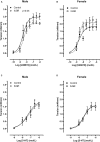Fetal Sex and Fetal Environment Interact to Alter Diameter, Myogenic Tone, and Contractile Response to Thromboxane Analog in Rat Umbilical Cord Vessels
- PMID: 34603067
- PMCID: PMC8481594
- DOI: 10.3389/fphys.2021.620058
Fetal Sex and Fetal Environment Interact to Alter Diameter, Myogenic Tone, and Contractile Response to Thromboxane Analog in Rat Umbilical Cord Vessels
Abstract
Fetal growth needs adequate blood perfusion from both sides of the placenta, on the maternal side through the uterine vessels and on the fetal side through the umbilical cord. In a model of intrauterine growth restriction (IUGR) induced by reduced blood volume expansion, uterine artery remodeling was blunted. The aim of this study is to determine if IUGR and fetus sex alter the functional and mechanical parameters of umbilical cord blood vessels. Pregnant rats were given a low sodium (IUGR) or a control diet for the last 7 days of pregnancy. Umbilical arteries and veins from term (22 day) fetal rats were isolated and set-up in wire myographs. Myogenic tone, diameter, length tension curve and contractile response to thromboxane analog U46619 and serotonin (5-HT) were measured. In arteries from IUGR fetuses, myogenic tone was increased in both sexes while diameter was significantly greater only in male fetuses. In umbilical arteries collected from the control group, the maximal contraction to U46619 was lower in females than males. Compared to the control groups, the maximal response decreased in IUGR male arteries and increased in female ones, thus abolishing the sexual dimorphism observed in the control groups. Reduced contractile response to U46619 was observed in the IUGR vein of both sexes. No difference between groups was observed in response to 5HT in arteries. In conclusion, the change in parameters of the umbilical cord blood vessels in response to a mild insult seems to show adaptation that favors better exchange of deoxygenated and wasted blood from the fetus to the placenta with increased myogenic tone.
Keywords: fetal adverse environment; rat; thromboxane analog; umbilical cords; vascular function.
Copyright © 2021 Sicotte and Brochu.
Conflict of interest statement
The authors declare that the research was conducted in the absence of any commercial or financial relationships that could be construed as a potential conflict of interest.
Figures









Similar articles
-
Fetal sex and the relative reactivity of human umbilical vein and arteries are key determinants in potential beneficial effects of phosphodiesterase inhibitors.J Appl Physiol (1985). 2024 Jun 1;136(6):1526-1545. doi: 10.1152/japplphysiol.00540.2023. Epub 2024 May 2. J Appl Physiol (1985). 2024. PMID: 38695358 Free PMC article.
-
Placental Underperfusion in a Rat Model of Intrauterine Growth Restriction Induced by a Reduced Plasma Volume Expansion.PLoS One. 2016 Jan 4;11(1):e0145982. doi: 10.1371/journal.pone.0145982. eCollection 2016. PLoS One. 2016. PMID: 26727492 Free PMC article.
-
The hemodynamics of late-onset intrauterine growth restriction by MRI.Am J Obstet Gynecol. 2016 Mar;214(3):367.e1-367.e17. doi: 10.1016/j.ajog.2015.10.004. Epub 2015 Oct 22. Am J Obstet Gynecol. 2016. PMID: 26475425
-
The change of umbilical cord components in intrauterine growth restriction comparative with normal growth fetuses by using sonographic measurement.J Med Assoc Thai. 2010 Dec;93 Suppl 7:S15-20. J Med Assoc Thai. 2010. PMID: 21294395
-
Vascular tone regulation in renal interlobar arteries of male rats is dysfunctional after intrauterine growth restriction.Am J Physiol Renal Physiol. 2021 Jul 1;321(1):F93-F105. doi: 10.1152/ajprenal.00653.2020. Epub 2021 May 31. Am J Physiol Renal Physiol. 2021. PMID: 34056927
Cited by
-
Maternal nano-titanium dioxide inhalation exposure alters placental cyclooxygenase and oxidant balance in a sexually dimorphic manner.Adv Redox Res. 2024 Apr;10:10.1016/j.arres.2023.100090. doi: 10.1016/j.arres.2023.100090. Adv Redox Res. 2024. PMID: 38562524 Free PMC article.
References
-
- Battista M. C., Oligny L. L., St-Louis J., Brochu M. (2002). Intrauterine growth restriction in rats is associated with hypertension and renal dysfunction in adulthood. Am. J. Physiol. Endocrinol. Metab. 283 E124–E131. - PubMed
LinkOut - more resources
Full Text Sources

